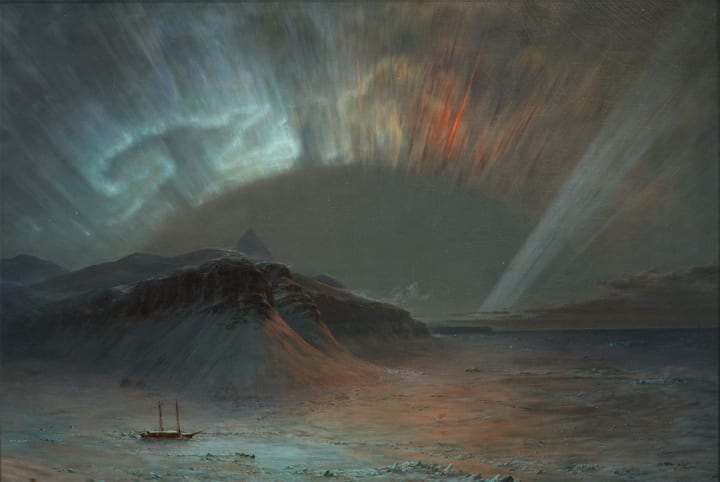Science of Auroras
How does the science of auroras explain the ethereal display of colored lights shimmering across the Northern and Southern altitude night skies?
Our atmosphere, the thin membrane that separates Earth from space, is a remarkable geophysical laboratory. In it are synthesized the fascinating colored lights known as auroras, one of nature's most splendid phenomena. Now that the sunspot cycle is reaching its peak, we can expect auroras to light up our night skies with greater frequency.
A dramatic account of man's early encounter with the aurora borealis, Or northern lights, is provided by the Romans. On a night in AD 37, they saw a red glow on the horizon in the direction of the bustling port of Ostia. Thinking the entire city on fire, they rushed to its aid, Only to find the city intact and the "fire" still in front of them. Earlier accounts tell of "flaming spears" seen in 503 B.C. and of a night sky "glowing in flames" above ancient Carthage several hundred years later The Word aurora, Latin for "dawn," was applied to this phenomenon by French astronomer-philosopher Pierre Gassendi after he had witnessed a bright aurora on November 12, 1621. The southern lights, or aurora australis, were named by Captain James Cook during a voyage in the South Pacific in 1773.
Auroral Displays

Image via Chris Martin Photography
An auroral display can take many forms. The simplest is a sheet of faint light, whitish or reddish, covering part of the sky More spectacular are the vast curtains, rays, arcs, and coronas of a full auroral show Light can dart quickly about the sky, changing shape and color in short order. The curtains may be pleated, forming a shape called the rayed arc. If you are directly underneath such a curtain, the aurora may appear as a corona. Arches are another common shape. The lambent light cast on the ground by a bright display can rival the light of the full moon. It is more than 250 times as bright as the band of the Milky Way arching across the summer sky.
On the average, about five auroras are seen over the northern United States and southern Canada each year. Perhaps once a year an aurora is visible over the southern United States. In times of great solar activity, auroras are more common and sometimes get even farther south. They have been seen—rarely—even in Mexico City. The peak auroral activity seems to come about two years after the sunspot peak. Since we are just now reaching the peak, the next two years should be ideal. The number of auroras is also related to the season. There are more in the spring and fall.
The Space Environment Services Center (SESC), in Boulder, Colorado, keeps tabs on the interaction between the sun and the earth's magnetic field. When unusual solar activity is likely to produce a big auroral display the SESC notifies the wire services. If you are technically minded, you can listen to the National Bureau of Standard's radio station WWV on frequencies of 2.5, 5, 10, 15, and 20 megahertz. Although the station's primary job is to give accurate time signals, other information is tucked in with the ticking of the atomic clock. At 18 minutes past each hour, WWV gives a brief report on Earth's magnetic field and solar activity. You'll need some references to decipher the information.
Auroras in Ancient Times

Image via NewEngland.com
To the Australian aborigines, auroras were the dances of the gods. Inhabitants of the Outer Hebrides were of similar mind. Na firchlis ("the merry dancers") is what auroras are called there. In the view of northern Germanic tribes, auroras were reflections in the shields borne by the Valkyries. Greenlanders believed they were spirits playing ball with the head of a walrus. The Tlingit of Alaska thought they were the dance fires of tribes farther north.
Referencing the science of auroras, we know that an aurora is produced by high-energy particles coming from the sun and falling through Earth's magnetic field. These particles strike the upper atmosphere and cause the atoms and molecules there to glow. Some geophysicists have compared the upper atmosphere to the screen of a giant television picture tube. In this analogy the geomagnetic field is the "electron gun" that is the source of particles.
Aristotle got somewhat close when he explained that an aurora was caused by vapors rising from the earth, Colliding with fire from the sun, and bursting into flame. The vapors, though, are there all along in the form of tenuous gases, mostly nitrogen and oxygen, more than 100 kilometers up. Just as a neon bulb glows when electricity flows through it and has a characteristic "neon color," each variety of atom or molecule in the upper air is excited by collisions with the incoming particles and glows with its own characteristic color: Nitrogen and hydrogen are red, and oxygen may be either red or green.
How Auroras Happen

Image via ESA
How far the incoming particles penetrate the atmosphere depends on their energy. Since most of the electrons have similar energy they are almost all stopped at the same height. For this reason the lower boundaries of the auroral curtains are sharp, about 100 kilometers above the earth. The upper edges of the curtains are fuzzy and frayed. While a curtain may be several thousand kilometers long from east to west, it is only a few hundred meters thick. The display can move at up to 100 meters a second, sometimes faster than the speed of sound. Consequently some auroras produce infrasonic sonic booms. Many observers studying the science of auroras have reported "swishing" noises associated with bright auroral displays. The exact nature of these sounds is still under investigation.
Auroras almost always appear in an "auroral oval," a sort of halo around the north and south magnetic poles. Since the magnetic poles are not in the same place as the geographic poles, and since the aurora is influenced by sunlight, the halos are askew Auroras glimmer most commonly around latitude 70 degrees north and south. When a particularly energetic burst of particles rains down from the Van Allen belts – magnetic bottles that trap and store particles near the earth—the auroral oval expands toward the equator. Then those living farther south may get a show in the sky.
There are still many details about the science of auroras to learn about how the energy of the solar wind-the stream of particles from the sun–is converted into the light of the aurora. We know that Earth is not alone in having auroras. Jupiter's strong magnetic field produces auroras seen by our space probes, and we could expect them in the atmosphere of any planet that has a magnetic field. Satellite and space-probe studies in the future hold a fuller explanation–both of our planet and of others. Scottish poet John T. Hughson summed it up nicely, even when we know the source of the northern lights, their drama and the beauty of the spectacle are undiminished.
About the Creator
George Gott
Writer & Social Media Editor for Jerrickmedia who is an avid reader of sci-fi and a fierce defender of women, minority, and LGBTQ rights.






Comments
There are no comments for this story
Be the first to respond and start the conversation.